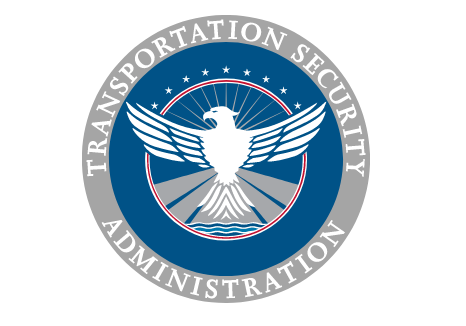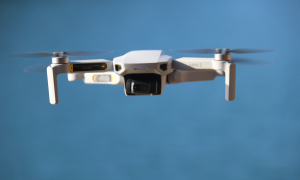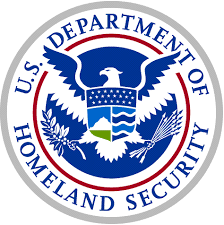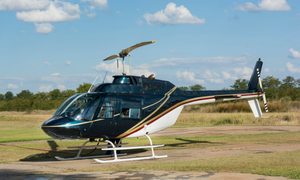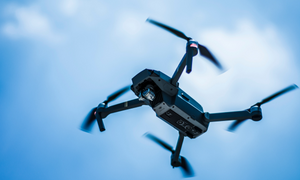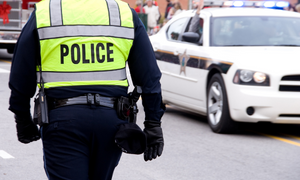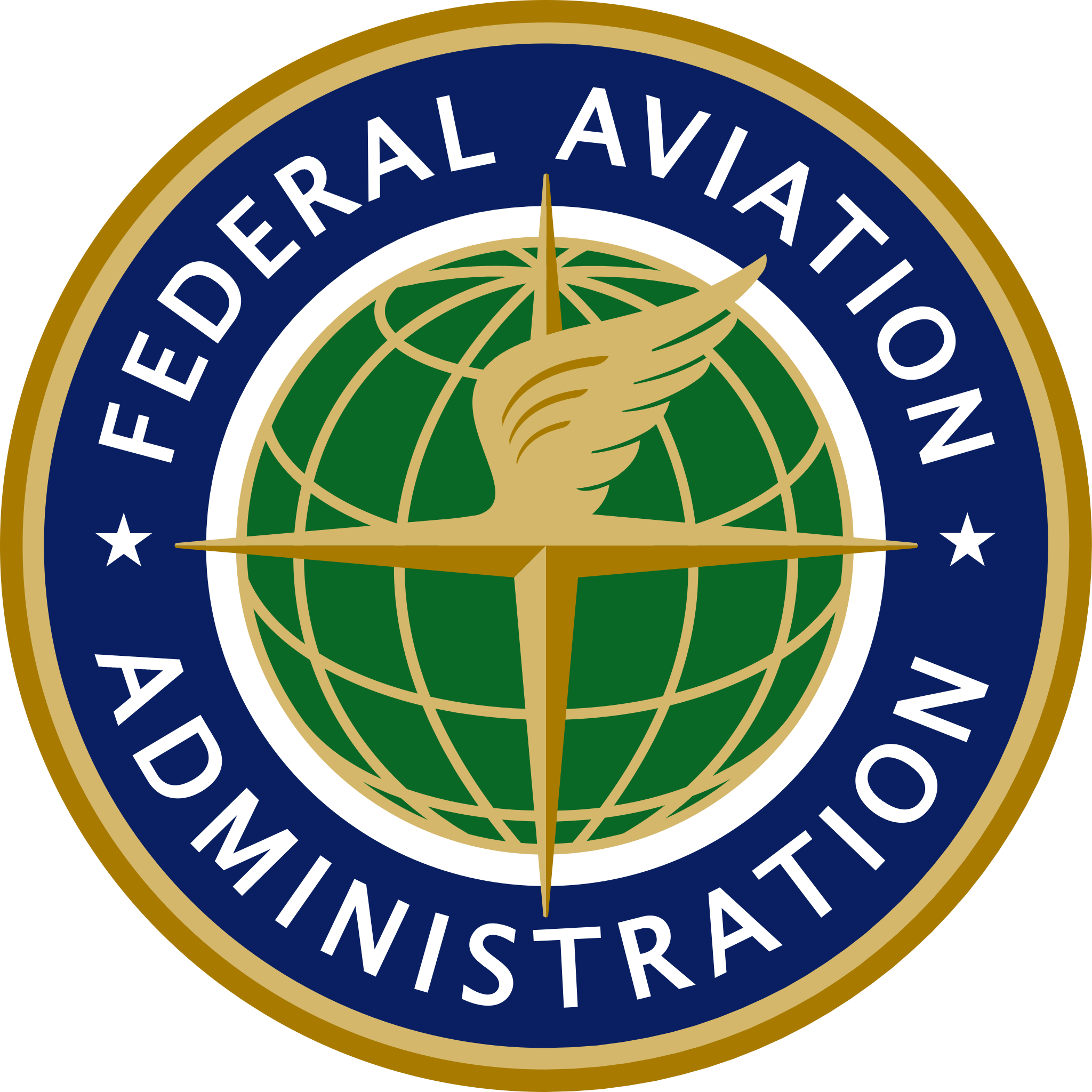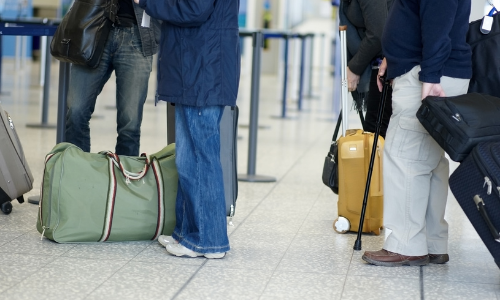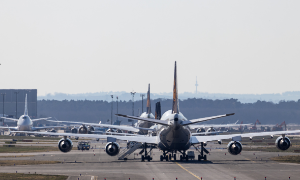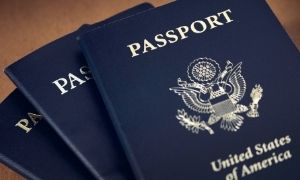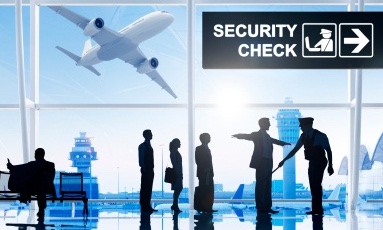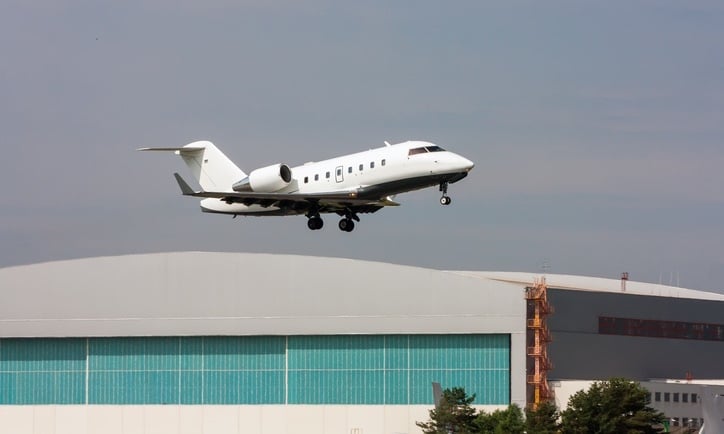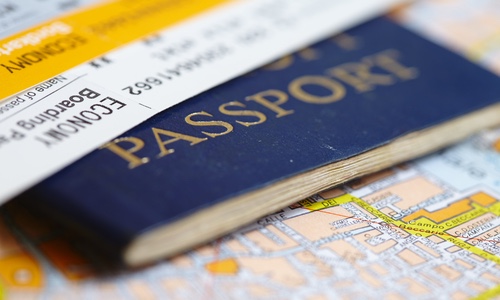Published by United States Attorneys Office District of New Jersey 27 February 2023
"NEWARK, N.J. – A Bergen County, New Jersey, man was charged following his attempt to bring firearms, ammunition, a bulletproof vest, fraudulent law enforcement credentials, and other items on a domestic flight to Fort Lauderdale, Florida, U.S. Attorney Philip Sellinger announced today.
"Seretse Clouden, 42, of Wallington, New Jersey, is charged by complaint with unlawful possession of firearms and ammunition by a convicted felon and fraudulent possession of an identification document and authentication feature of the United States. He made his initial court appearance today before the U.S. Magistrate Judge James B. Clarke III in Newark federal court and was detained."
To read this press release, click here.
Green UAS: New Program to Vet Commercial Drones for Security
Published by Drone DJ 23 February 2023
"The Association for Uncrewed Vehicle Systems International (AUVSI) has unveiled Green UAS, a new cybersecurity and supply chain risk assessment program for commercial drones. The program’s framework closely mirrors the Pentagon tech hub Defense Innovation Unit’s Blue UAS model. But it is aimed at those government and nongovernment users who do not immediately require Department of Defense (DoD) authority to operate commercial drones."
To read this article, click here.
Bomb Squad Responds to Manchester-Boston Regional Airport for Reported Security Threat
Published by 10 Boston 11 February 2023
One of the common security situations that airports face are bomb threats. Most are quickly determined to be hoaxes but every threat made against an airport or an aircraft must be taken seriously.
When a security incident was reported at Manchester-Boston Regional Airport, multiple agencies and first responders were called to the scene.
To read this article, click here.
Drones Fuel Contraband Trade at SC Prisons; Federal Government Called to Act
Published by The Post and Courier Columbia 5 February 2023
"COLUMBIA — Drones flying over prison fences, dropping packages of contraband, likely enabled two state prison inmates to get their hands on a cellphone and use it to help orchestrate a drug-trafficking operation in which methamphetamine was smuggled from Mexico to South Carolina’s Upstate.
"The contraband drop-offs by drone have become a nightly battle at state prisons and continue to fuel an illegal, high-demand trade among inmates, supplying them with drugs, tobacco, knives and some with cellphones, which the state prisons chief said is a top threat to public safety, allowing some to arrange drug-trafficking operations and even plot murder."
To read this article, click here.
Pilots Asked to Help Fight Human Trafficking - Bringing GA Into the Conversation
Published by AOPA 2 February 2023
"The U.S. Department of Homeland Security hosted aviation industry professionals on January 26 for the Combating Human Trafficking in Aviation Summit with the Blue Lightning Initiative, an element of the Blue Campaign—a DHS push to promote public, law enforcement, and industry awareness about indicators of human trafficking and appropriate responses when encountering it.
"The Blue Lightning Initiative focuses specifically on training aviation personnel on this awareness, providing instruction on the identification of potential traffickers and human trafficking victims and learning how to inform law enforcement if and when trafficking is identified. At the summit, subject matter expects, initiative partners, and a lived experience expert all spoke about their experiences with human trafficking while also touching on best practices for combating the crime."
To read this article, click here.
Theft Investigation Underway at the Local Airport in Douglas
Published by Fox 31 27 January 2023
"According to a Facebook post from Douglas Police Department, the suspect then proceeded to walk across a field, around the hangars, and approach several airplanes. The suspect chose only one specific airplane to enter.
"The suspect then stole several thousands of dollars worth of electronics from inside the plane and left the same way that they walked to the plane."
To read this article, click here.
Port of Port Angeles Increasing Security After Airport Break-Ins
Published by Peninsula Daily News 17 January 2023
"PORT ANGELES — A number of thefts and vehicle break-ins at Fairchild International Airport and the Industrial Park has the Port of Port Angeles set to make some adjustments in security.
“We have had several thefts of items from the long-term parking at the airport, and we have also had some theft of items from the airport industrial park,” said Paul Jarkiewicz, director of operations for the port, during the organization’s Jan. 10 meeting."
To read this article, click here.
Biometric Boarding Takes Off at Philadelphia International Airport
Published by Homeland Security Today 7 January 2023
"Philadelphia International Airport (PHL) is installing facial biometric technology at 25 boarding gates in Terminals A-East and A-West to help U.S. Customs and Border Protection (CBP) process departing passengers on international flights safely and efficiently.
"The facial biometrics process is designed to verify travelers’ identities by comparing a live photo to images that the traveler has already provided to the government, such as passport and visa photos."
To read this article, click here.
Boston Man, Traveling with Child, Faces Charges After Bringing Loaded Gun Through Airport Security
Published by Yahoo! News 29 December 2022
"A Hyde Park man was held without bail after being arrested Wednesday for attempting to bring a loaded gun through a security checkpoint at Logan Airport, District Attorney Kevin Hayden announced Thursday afternoon.
"Lorenzo Beechman, 36, was traveling with a child Wednesday when he placed a loaded gun inside a shoebox covered by a brown paper bag and attempted to get it through security."
To read this article, click here.
Security Breach That Disabled Radar, Shut Down Cleveland Hopkins Shows Need for Additional Perimeter Safeguards
Published by Cleveland.com 22 December 2022
"CLEVELAND, Ohio – On the busy travel day before Thanksgiving, Isaac Woolley drove to the main radar tower at Cleveland Hopkins International Airport, disabled a gate, deactivated the radar’s main power source, climbed eight flights of stairs, shut off a second power source and pulled several wires from the radar, rendering it inoperable, according to federal court records."
To read this article, click here.
Getting Through TSA Will Be Easier and Quicker in 2023—Here’s Why
Published by Afar 22 December 2022
"...the U.S. Transportation Security Administration (TSA) has been gradually investing in technology and expanding programs that will, quite frankly, move things along at a more rapid clip. Many of these programs were actually initiated well before the pandemic and were either put on hold or put on the back burner as the country shifted gears to address the COVID crisis. But as TSA turns its sights back to these initiatives, many of the things that we’ve become accustomed to doing during the security screening process—showing TSA agents our boarding pass and a valid ID, removing liquids and laptops from our carry-ons—could soon become a thing of the past."
To read this article, click here.
Trusted Traveler Status Revoked Over ‘Jetlag’
Published by Homeland Security Today 10 December 2022
"Jetlag got a Miami man booted from U.S. Customs and Border Protection’s trusted traveler program on Thursday at Philadelphia International Airport....
"...CBP officers discovered a green leafy substance in a ziplocked bag labeled “The Plug – Jetlag” inside a toiletry bag. That substance tested positive for cannabis. The marijuana weighed 2.5 grams. Marijuana possession remains illegal under U.S. federal law."
To read this article, click here.
Man Faces State, Federal Charges for Driving Onto Restricted Area at Cleveland Airport
Published by 19 News 28 November 2022
"CLEVELAND, Ohio (WOIO) - A 26-year-old man accused of carjacking a vehicle in Fairview Park and then driving onto a restricted area at Cleveland Hopkins International Airport last week is now facing state and federal charges.
"Fairview Park police charged Isaac Woolley, 26, with grand theft motor vehicle and attempted felonious assault and the U.S. Attorney for the Northern District of Ohio charged him with entering an aircraft or airport area in violation of security requirements, carjacking and destruction of aircraft or aircraft facilities."
To read this article, click here.
FBI Cites Bomb-Toting UAV Inquiries in Urging Counter-Drone Action
Published by DroneDJ 18 November 2022
"The director of the Federal Bureau of Investigations (FBI) has joined a chorus of voices urging Congress to take steps to maintain or expand the counter-drone capacities of US security authorities, backing up his urging with revelations of the agency’s ongoing investigations into UAVs being equipped to transport homemade bombs."
To read this article, click here.
East Brookfield Man Sentenced for Illegally Operating a Helicopter, Making False Statements and Attempted Witness Tampering
Published by The United States Attorney's Office District of Massachusetts 18 November 2022
"Defendant previously participated in the theft of a helicopter from Norwood Memorial Airport
"BOSTON – An East Brookfield man was sentenced today in federal court in Worcester for unlawfully operating a helicopter, making false statements to federal investigators and attempting to tamper with a witness."
To read this news release, click here.
Stolen Plane Engine Leads to Recovery of Stolen Equipment in Sunflower County [Mississippi]
Published by WJTV 14 November 2022
"SUNFLOWER COUNTY, Miss (WJTV) – Authorities said a stolen airplane engine led to the discovery of a large cache of stolen equipment in Sunflower County, Mississippi.
"On Friday, November 4, investigators said the engine was stolen off of an airplane that was stored in a crop-duster hanger in Issaquena County. The theft was reported to the Issaquena County Sheriff’s Office, and the Mississippi Agricultural and Livestock Theft Bureau (MALTB) was asked to assist in the theft investigation."
To read this article, click here.
Countering Clueless, Careless, Criminal and Combatant Drone Users
Published by Inside Unmanned Systems 7 November 2022
"The FAA estimates that by 2024 about 2.3 million drones—1.5 million recreational drones and model aircraft and more than 800,000 commercial drones—will be registered to fly in U.S. National Airspace System (NAS). As drone numbers increase, so do reports of negative encounters with them. In the past two years, the Department of Homeland Security has logged more than 2,000 drone sightings in and around U.S. airports and more than 8,000 illegal cross-border drone flights at the southern border."
To read this article, click here.
Stop Pointing Lasers at Aircraft! Here’s How Often Dangerous Laser Strikes Happen Near You.
Published by USA Today 27 October 2022
"Ground-based lasers have struck aircraft in the United States and its territories more than 74,000 times since 2010, and the risky phenomenon is on the rise, according to a USA TODAY analysis of the Federal Aviation Administration data reported by flight crews.
"Small laser pointers used for business presentations, entertaining pets or pointing out stars might be the most familiar type for ordinary people. But affordable higher-powered laser pointers are also widely available online. Aiming either kind at an airplane is dangerous, experts say, and it's a federal crime."
To read this article, click here.
Opinion: The Security Risk Congress Needs to Take Seriously
Published by CNN 5 October 2022
The Secretary of Homeland Security, Alejandro Mayorkas, writes in his new opinion piece: "Football watch parties saw unexpected interruptions recently when low flying drones over the gridiron forced NFL and college football games to stop. In both instances, the drones flew away without incident and there was no risk to fans attending, but each demonstrates the potential public safety threat unmanned aircraft systems (UAS) or “drones” pose to the public, and the need for tools to address it."
To read this opinion, click here.
Drone Swarms Aren’t Science Fiction. America Must Meet This Threat.
Published by The Heritage Foundation 28 September 2022
Suppose an adversary put together a drone swarm of 2,000 to 3,000 small and medium unmanned aerial vehicles, maybe even up to 10,000 such UAVs. By launching such a swarm at a set of industrial targets, overseas military bases, or naval vessels, a rogue actor could tip the scales of a weak Washington administration’s policies.
To read this article, click here.
Building a Robust Drone Security Framework for Safer UAS Integration into National Airspace System
Published by Homeland Security Today 15 September 2022
"The United States is using every tool at its disposal to help combat the risks posed by non-compliant actors using unmanned aircraft systems (UAS) or drones.
"The FAA’s primary role in the detection and mitigation of drones is to ensure the safety, security, and efficiency of the National Airspace System (NAS) as it pertains to both manned and unmanned aircraft. We are constantly working to welcome these beneficial new technologies while minimizing any impacts to our air transportation system or to the public."
To read this article, click here.
The Critical Job of Keeping America’s Skies Safe
Published by Security Infowatch.com 9 September 2022
"When we talk about infrastructure, there a few things more critical to the national transportation hub than our airports. The impact was devastating on the morning of September 11, 2001, when Mohamed Atta and 18 other al-Qaida-affiliated terrorists checked into their various flights emanating from Boston's Logan International Airport, Liberty International Airport in Newark, N.J., and Dulles International Airport in Washington, D.C., with the sole mission of using passenger aircraft as fuel-filled ariel missiles."
To read this article, click here.
TSA Announces Minneapolis-St. Paul International Airport (MSP) Passenger Screening Canine Eebbers Voted the “2022 Cutest Canine”
Published by Transportation Security Administration 26 August 2022
"WASHINGTON – The Transportation Security Administration (TSA) announced today that Eebbers, an 11-year-old explosive detection canine who works at Minneapolis-St. Paul International Airport (MSP) in St. Paul, Minnesota, was voted the winner of TSA’s 2022 Cutest Canine Contest."
To read this press release, click here.
TSA Begins Testing Drone Detection Technology at LAX
Published by Homeland Security Today 26 August 2022
"The Transportation Security Administration (TSA) has begun testing state-of-the-art technology designed to detect, track and identify (DTI) drones entering restricted airspace around Los Angeles International Airport (LAX). Drones, also known as Unmanned Aircraft Systems (UAS), pose a security threat to transportation security when flown into certain restricted airspaces. LAX joins Miami International Airport in TSA’s UAS Test Bed Program as one of two locations nationwide currently testing this type of technology in an operational airport environment."
To read this article, click here.
All Eyes on the Skies During Aviation Week
Published by U.S. Department of Homeland Security Science and Technology 19 August 2022
"Every August, from the 19th through the 25th, the United States observes National Aviation Week. The week serves as a celebration of our nation’s long aviation history dating back to 1793 with the launch of a hot air balloon in Philadelphia, and notably, with George Washington in attendance. From that first launch to the historic Wright brothers flight in 1903 to present-day airplane travel, we commemorate all the achievements in between. Here at the Science and Technology Directorate’s (S&T) Transportation Security Lab (TSL), we’re celebrating National Aviation Week with a reflection on some of our own aviation technologies that keep the flying public safe and a look at how TSL continuously makes improvements to the Transportation Security Administration’s (TSA) ability to screen passengers, luggage, and cargo for explosives and other threats."
To read this post, click here.
TSA Officers Detect Artfully Concealed Firearm Parts at Newark Liberty International Airport
Published by Transportation Security Administration 28 July 2022
"NEWARK, N.J.— A Bergen County, N.J., man was denied boarding his flight after Transportation Security Administration (TSA) officers at Newark Liberty International Airport detected numerous firearm parts that had been artfully concealed in one of the man’s checked bags late last night, Wednesday, July 27."
To read this press release, click here.
Dallas Police Release Video of Officer Shooting Woman Who Fired Gun at Dallas Airport
Published by CNN 27 July 2022
"The Dallas Police Department released edited surveillance and body camera video of a woman who fired a gun at Dallas Love Field Airport Monday and was taken down by a police officer.
"Portia Odufuwa, 37, has been charged with aggravated assault against a public servant, and other federal charges are possible, Dallas Police Chief Eddie Garcia said in a news conference Tuesday."
To read this article, click here.
New Airport Detection System is Aviation Security’s Next Innovative Step
Published by Security Infowatch 15 July 2022
"Kair has just seen a U.S. patent issued on his innovative system to enhance aviation security operations and provide significantly higher officer performance and efficiency. The Chertoff Group, partnering with IDSS to develop a solution based on Open Architecture DICOS imaging standards utilizing this patented technology, which will allow access and interoperability with any checkpoint or checked baggage computed tomography (CT) system located anywhere in the world."
To read this article, click here.
Man Accused of Using Drone to Smuggle Contraband Into Prison
Published by Spectrum News1 13 July 2022
"BEAUMONT, Texas (AP) — A Houston man was indicted on charges accusing him of trying to use a heavy-duty drone to drop a bag of forbidden items to inmates at a federal prison in Texas, authorities announced Tuesday.
"Federal officials unsealed an indictment charging Davien Philip Turner with two counts of unlawfully flying an aircraft. Each count is punishable by up to three years in prison."
To read this story, click here.
News Release: DHS S&T Conducts Remote Screening Demonstration at Cape Cod Gateway Airport
Published by U.S. Department of Homeland Security 28 June 2022
"WASHINGTON – The Department of Homeland Security (DHS) Science and Technology Directorate (S&T) successfully conducted a demonstration of remote screening infrastructure for airport security checkpoints with the developer, Integrated Defense & Security Solutions (IDSS), on June 23 at the Cape Cod Gateway Airport in Hyannis, Massachusetts."
To read this news release, click here.
3 Injured in Attack at San Francisco International Airport
Published by CBS News 18 June 2022
"San Francisco — A man with an "edged weapon" attacked passengers inside a San Francisco International Airport terminal on Friday, leaving three with cuts and scrapes before he was arrested, authorities said.
"The man drove to the airport, went into the International Terminal, "walked around the departure terminal and pulled out an edged weapon" before attacking three men at about 6 p.m., police said."
To read this article, click here.
Strategy to Prevent the Importation of Goods Mined, Produced, or Manufactured with Forced Labor in the People’s Republic of China
Published by U.S. Department of Homeland Security 17 June 2022
"The Uyghur Forced Labor Prevention Act was enacted on December 23, 2021, to strengthen the existing prohibition against the importation of goods made wholly or in part with forced labor into the United States and to end the systematic use of forced labor in the Xinjiang Uyghur Autonomous Region. Among its mandates, the UFLPA charged the Forced Labor Enforcement Task Force, chaired by DHS, to develop a strategy for supporting the enforcement of Section 307 of the Tariff Act of 1930, as amended (19 U.S.C. § 1307) to prevent the importation into the United States of goods mined, produced, or manufactured wholly or in part with forced labor in the People’s Republic of China."
To read this strategy, click here.
TSA Trials Pangiam’s AI-Driven Solution to Improve Airport Threat Detection
Published by AviationPros 15 June 2022
"The Transportation Security Administration (TSA) selected transport security technologists Pangiam to demonstrate its artificial intelligence (AI)-driven accessible screening solution that has the potential to transform aviation security worldwide.
"Project DARTMOUTH, the collaboration between Pangiam and Google Cloud, utilizes artificial intelligence (AI) and pattern analysis technologies to digest and analyze vast amounts of data in real-time to identify potential prohibited items in carry-on baggage."
To read this article, click here.
CBP Rolls Out Biometric Scanning at All U.S. Intl Airports
Published by AINonline 2 June 2022
"As it works to secure and modernize international travel, U.S. Customs and Border Protection (CBP) has completed the introduction of biometric facial comparison technology at all international airports across the country. Simplified Arrival is an enhanced arrival process designed to fulfill a Congressional mandate to biometrically record the entry and exit of non-U.S. citizens."
To read this article, click here.
Georgia Man Who Assaulted an Airport Security Agent Sentenced to Federal Prison
Published by United States Justice Department 27 May 2022
"A man who was caught taking marijuana and over $37,000 in cash through the Eastern Iowa Airport security screening was sentenced today to two months in federal prison and fined $2,000."
To read this press release, click here.
TSA Enables Maryland Residents to Use Mobile Driver’s License or State ID for Verification at Baltimore/Washington International and Reagan National Airports
Published by Transportation Security Administration 25 May 2022
"BALTIMORE, Md. – The Transportation Security Administration (TSA), in collaboration with the State of Maryland and Apple, deployed a new technology that allows airline passengers to use their Maryland-issued mobile driver’s license or mobile identification card in Apple Wallet to safely and seamlessly present and verify their identity for airport security screening purposes at Baltimore/Washington International Thurgood Marshall (BWI) and Ronald Reagan Washington National (DCA) airports. Maryland joins Arizona as the second state to offer this feature."
To read this press release, click here.
Abilene Man Arrested for Stealing Airport Refueling Truck Following Hit & Run Crash
Published by SanAngeloLIVE.com 12 May 2022
Questions are left unanswered as to how a transient man managed to access and steal a refueling truck at Abilene Regional Airport in Abilene, Texas.
The man was eventually stopped by police and no motive was given for his behavior.
To read this article, click here.
S&T Tech Leads to Children Rescued and Traffickers Arrested
Published by U.S. Department of Homeland Security 9 May 2022
"The Department of Homeland Security (DHS) is fiercely dedicated to countering human trafficking across the country and around the world, no matter how difficult or time consuming the mission may be. That’s why the Science and Technology Directorate (S&T) has teamed up with Homeland Security Investigations (HSI) and others to develop the enhanced analytic platforms, tools, and capabilities required to do this important work."
To read this article, click here.
TSA Officials Commemorate 20th Anniversary of the Federalization of First Airport After TSA was Established BWI was the First Airport that TSA “Stood Up” After 9/11 Terrorist Attacks
Published by Transportation Security Administration 29 April 2022
"LINTHICUM, Md. — Officials from the Transportation Security Administration (TSA) and Baltimore/ Washington International Thurgood Marshall Airport (BWI) commemorated the 20th anniversary of the federalization of the airport. BWI was the first airport to launch under TSA security oversight on April 30, 2002, with a security checkpoint staffed by federal TSA officers only a few months after the terrorist attacks of Sept. 11, 2001."
To read this press release, click here.
FAA invests $1 billion of Bipartisan Infrastructure Law Funding into ATC
Published by International Airport Review 29 April 2022
The FAA (Federal Aviation Administration) provides oversight for thousands of airports and flights across the United States each day. One of the integral pieces of that oversight is the security of those who pass through them.
Part of the $1 billion will be used to "upgrade various integrated security systems at all FAA staffed facilities. Upgrades include those for guardhouses, visitor parking, fencing, perimeter hardening, window blast protection and lighting."
To read this article, click here.
LA County to Keep Requiring Masks on Public Transit After Ruling on Federal Mandate
Published by The Hill 21 April 2022
"The Los Angeles County Department of Public Health said on Thursday that the county will continue to require masking on public transportation systems, breaking with a recent ruling by a federal judge in Florida, which struck down the federal mask mandate on transportation systems.
"The department noted it is issuing a health order to say that masking will continue to be required in indoor transportation hubs such as bus and airport terminals and on all public transportation — including ride-shares, trains and buses — within Los Angeles County."
To read this article, click here.
Boston Logan Airport Pilot Hit by Potentially Blinding Laser Strike; National Laser Strikes Jump 41% Over the Past Year
Published by Mass Live 19 April 2022
"A pilot flying into Boston Logan Airport on Sunday night said a blue laser beam was flashed over his eyes as he descended into the airport runway, according to CBS Boston.
"Authorities told reporters that the incident occurred around 11 p.m. on Sunday. The pilot of the Embraer 190 regional jet was reportedly flashed by a blue laser beam while 4,000 feet in the sky, just before safely landing on the Logan Airport runway."
To read this article, click here.
ICE HSI Washington, DC Teams Up with the Virginia State Police to Launch "Operation Safe Passage" to Detect, Deter, and Raise Awareness of Human Trafficking
Published by U.S. Immigration and Customs Enforcement 18 April 2022
"WASHINGTON – U.S. Immigration and Customs Enforcement’s (ICE) Homeland Security Investigations (HSI) Washington, D.C. partnered with the Virginia State Police and the Virginia Trucking Association in order to detect, deter, and raise awareness of the growing problem of human trafficking. During mid-April, they will conduct Operation Safe Passage, a high‐visibility, human trafficking prevention and public outreach initiative. The operation kicked off at 10:00 a.m. on April 18, during a ceremony at the Virginia Welcome Center in on I-95 in Caroline County, Virginia. The operation will continue through April 20."
To read this press release, click here.
CDC Lowers COVID-19 Warnings for Canada, Argentina, Jamaica
Published by The Points Guy 9 April 2022
"The U.S. Centers for Disease Control and Prevention (CDC) has lowered its Level 4 “very high” COVID-19 travel warnings for 14 countries including Canada and Argentina. At the same time, Jamaica is among five countries previously listed as “moderate” risk and now designated as “low” risk for contracting COVID-19.
"The warnings are based on the likelihood of contracting COVID-19 while traveling. At all warning levels, the federal health agency recommends travelers be fully vaccinated."
To view the CDC guidance and map, click here.
To read this article, click here.
Pennsylvania Individual Sentenced for Aiming Laser Pointer at Police Helicopter
Published by U.S. Department of Transportation, Office of Inspector General 7 April 2022
"On April 7, 2022, the U.S. District Court for the Eastern District of Pennsylvania sentenced Raji Yusuf to 1 year in prison, 3 years of supervised release, a $1,000 fine, and a $100 special assessment for aiming a laser pointer at an aircraft and violating the terms of supervised release. In December 2021, Yusuf pleaded guilty to aiming a laser pointer at a Philadelphia Police helicopter while it was in flight. At the time of the incident, Yusuf was on Federal supervision for a 2016 conviction for trafficking firearms."
To read this press release, click here.
Airport Workers Trained to Stop Child Sex Traffickers
Published by Fox 29 7 April 2022
"More than seven million travelers came through San Antonio's International Airport in 2021. Authorities say it's a place where traffickers can also lurk because they feel comfortable hiding among the crowds.
"We have partnered with Ransomed Life as part of their 'No Child Sold' campaign. Ransomed Life held a training session for airport staff on what to do and say if something doesn’t look quite right."
To read this article, click here.
Texas Man Chartered Private Plane to Transport Cocaine from Houston to Pittsburgh
Published by Department of Justice, U.S. Attorney's Office, Western District of Pennsylvania 6 April 2022
"A resident of Houston, Texas, pleaded guilty in federal court to violating federal narcotics laws related to a nine-month Title III wiretap investigation into drug trafficking in and around the counties of Jefferson, Clearfield, and Allegheny, United States Attorney Cindy Chung announced today."
To read this press release, click here.
Similarities at Data Centers and Airports
Published by Security Today 1 April 2022
"Few sectors face higher regulation and compliance standards in the United States than the aviation industry. With more than 2.9 million passengers flying daily in the United States and an annual economic impact of $1.9 trillion, the aviation industry is critical infrastructure which must be protected through rigorous security procedures. ACTS understands these requirements and works closely with the Transportation Security Administration (TSA) to enact security standards which protect the traveling public at all four airports which we secure, Pittsburgh International Airport (PIT), Cincinnati/Northern Kentucky International Airport (CVG), Minneapolis-St. Paul International Airport (MSP), and Charlotte Douglas International Airport (CLT)."
To read this article, click here.
TSA Announces Measures to Implement Gender-Neutral Screening at Its Checkpoints
Published by Transportation Security Administration 31 March 2022
"WASHINGTON – The Transportation Security Administration (TSA) announced new standards for screening transgender, nonbinary, and gender-nonconforming airline passengers at TSA checkpoints to improve the screening experience for all passengers."
To read this article, click here.
Trespasser Runs Onto The Runway At Chicago Midway Airport
Published by Simple Flying 31 March 2022
"A trespasser managed to breach security and access a runway at Chicago Midway, where he attempted to climb onto the wing of a private jet. The man hopped over a barbed-wire fence before being arrested approximately 15 minutes later."
To read this article, click here.
Implementing Mobile Driver’s Licenses: Not as Easy as You Think
Published by U.S. Department of Homeland Security 29 March 2022
"Currently, physical government-issued IDs, primarily driver’s licenses, are must-haves for security checkpoints such as those at the nation’s airports staffed by agents of the Transportation Security Administration (TSA). These days, though some passengers show passports or other IDs, the majority do present driver’s licenses at airport checkpoints. As adults, we cannot fly on a commercial airliner without a physical ID; for now, that is.
"You may be interested to learn that physical driver’s license holders may soon be able to apply for Mobile Driver’s Licenses (mDLs) stored on smartphones if they want to move to a digital ID, thanks to a collaborative project involving the Science and Technology Directorate (S&T), National Institute of Standards and Technology (NIST), and TSA."
To read this press release, click here.
Chicago CBP Notices International Travelers Returning to the Friendly Skies
Published by U.S. Customs and Border Protection 29 March 2022
"CHICAGO– More and more travelers are ensuring their tray tables and seats are in the upright position as they land in Chicago. U.S. Customs and Border Protection (CBP) officers at O’Hare International Airport are seeing numbers that haven’t seen since 2019 as passengers are starting to travel, and tourism is returning to the Chicago area for the first time in several years."
To read this press release, click here.
New TSA Technology Could Mean No More Removing Laptops or Liquids
Published by AFAR 24 March 2022
"The Transportation Security Administration may have found a way to make the airport security process a little quicker, courtesy of some high-tech scanners.
"The new full-size Computed Tomography (CT) x-ray systems in question create 3D images of carry-on items, detecting weapons, explosives, and other prohibited items more accurately than current scanners—similar to what hospitals use to look at patients’ internal organs. The new technology will hopefully allow passengers to keep liquids and laptops in their luggage, speeding up the oftentimes sluggish security lines."
To read this article, click here.
TSA Enables Arizona Residents to Use Mobile Driver’s License or State ID for Verification at Phoenix Sky Harbor International Airport
Published by Transportation Security Administration 23 March 2022
"WASHINGTON – The Transportation Security Administration (TSA), in collaboration with the State of Arizona and Apple, deployed a new technology that allows airline passengers to use their state-issued mobile driver’s license or mobile identification card in Apple Wallet on iPhone or Apple Watch to verify their identity for airport security screening purposes.
"Starting today at Phoenix Sky Harbor International Airport (PHX), individuals with driver’s licenses or state IDs issued by the State of Arizona will be able to add a digital version of their license or ID to their Apple Wallet for TSA identity verification purposes."
To read this press release, click here.
Technological Advances Take Airport X-Ray Scanners to the Next Level
Published by Transport Security International 20 March 2022
"Software-driven artificial intelligence along with its focused self-improvement process, machine learning (AI/ML) is supercharging airport screening systems, thanks to its ability to sift through massive amounts of data (aka Big Data), analyze its contents against a set of preset parameters, and learn from this work to enhance its processes and analytical conclusions."
To read this article, click here.
US Customs Agents Seize Aircraft in St. Thomas Allegedly Tied to Smuggling Activities
Published by Caribbean News Weekly 14 March 2022
"The United States Customs and Border Protection (CBP) agency says officers from its Air and Marine Operations (AMO) have seized an aircraft in St Thomas, US Virgin Islands, suspected of being used for “smuggling events.
"CBP said during an arrest conducted in the fall of 2021, AMO agents working with US Drug Enforcement Administration agents and US Immigrations and Customs Enforcement, Homeland Security Investigation agents detected items in connection with past aviation smuggling events."
To read this article, click here.
Baltimore CBP Seizes $2.5 Million in Palm Oil Shipments Under Forced Labor Finding
Published by U.S. Customs and Border Protection 8 March 2022
"BALTIMORE – U.S. Customs and Border Protection (CBP) officers seized four shipments of palm oil in Baltimore since February 11 due to information indicating that the palm oil was manufactured by forced labor, a form of modern slavery. The palm oil shipments are valued at nearly $2.5 million.
"All four shipments of palmitic acid were produced in Malaysia and destined to a processing facility in Delaware. The combined weight of the four shipments of palmitic acid came to 544,176 pounds and had an appraised value of about $2,466,500.
"On January 28, CBP issued a Notice of Finding to the Federal Register [FRN 2022-01779] that certain palm oil and derivative products made wholly or in part with palm oil produced in Malaysia with the use of convict, or forced or indentured labor are inadmissible in violation of 19 USC 1307 and 19 CFR 12.42."
To read this press release, click here.
Ukraine Travel Advisory
Published by U.S. Department of State - Bureau of Consular Affairs 8 March 2022
"Do not travel to Ukraine due to armed conflict and COVID-19. U.S. citizens in Ukraine should depart immediately if it is safe to do so using any commercial or other privately available ground transportation options. U.S. citizens should not travel to Ukraine due to the active armed conflict. All U.S. citizens should carefully monitor government notices and local and international media outlets for information about changing security conditions and alerts to shelter in place. Those remaining in Ukraine should exercise increased caution due to the potential for active combat, crime, and civil unrest."
To read this advisory, click here.
Hawaii Travel Is About To Get A Lot Easier: Here’s What You Need To Know
Published by The Points Guy 3 March 2022
"As of March 26, domestic travelers to Hawaii will no longer have to comply with the state’s Safe Travels program, ending testing and vaccination requirements for those arriving in Hawaii from within the United States."
To read this article, click here.
Private Jet Tracking: How it Happens and How You Might Stop it
Published by Business Jet Traveler February 2022
"Nineteen-year-old Jack Sweeney made headlines recently for creating Twitter accounts that track private jets owned by people like Elon Musk and Bill Gates. Musk offered him $5,000 to delete the account, but Sweeney claimed to be having so much fun keeping tabs on the billionaire’s jet, a Gulfstream G650ER, that the money wasn’t enough to motivate him to stop."
To read this article, click here.
TSA Establishes First International Location for TSA PreCheck® in The Bahamas
Published by Transportation Security Administration 24 February 2022
"WASHINGTON - The Transportation Security Administration (TSA) expanded TSA PreCheck® to an international location for the first time at a ribbon cutting ceremony earlier with the Commonwealth of The Bahamas at Lynden Pindling International Airport in Nassau.
"TSA PreCheck is an expedited screening program that enables low-risk travelers to enjoy an efficient screening experience at more than 200 airports in the United States and Nassau."
To read this press release, click here.
DHS Designated As The Lead Federal Agency To Respond To Russia-Related Impacts To The United States
Published by U.S. Department of Homeland Security 24 February 2022
"The President has designated the Department of Homeland Security (DHS) as the lead Federal agency to coordinate domestic preparedness and response efforts related to the current Russia-Ukraine crisis. While there are no specific threats to the homeland at this time, DHS is taking appropriate steps to ensure Federal efforts are coordinated should the need arise."
To read this press release, click here.
NATA, ACSF Forum Brings Call for Broad Safety Standards
Published by Aviation International News 24 February 2022
"More than 50 business aviation leaders gathered this week for a first-of-its-kind event co-hosted by the National Air Transportation Association (NATA) and Air Charter Safety Foundation (ASCF) to have an open conversation about the most pressing safety issues confronting the industry and develop recommendations on addressing them. The participants view the event as “the beginning of a process” in which they can collaboratively develop key performance indicators (KPIs), best practices, and industry standards, and share them throughout the industry."
To read this article, click here.
ICE HSI Participates In Multi-Agency Human Trafficking Operation
Published by U.S. Immigration and Customs Enforcement 22 February 2022
"PHOENIX – Special agents with U.S. Immigration and Customs Enforcement’s (ICE) Homeland Security Investigations (HSI) joined a multi-agency collaborative effort aimed at confronting and reducing human trafficking-related crimes in the valley.
"The Phoenix Police Department’s Human Exploitation and Trafficking Unit (HEAT) spearheaded the two-phase approach beginning in January through February. The Phoenix HEAT unit worked with human trafficking units from Scottsdale, Glendale, Mesa, Tempe, HSI and FBI to address the problem in the greater Phoenix area. This joint operation was conducted in Scottsdale and Phoenix and resulted in 118 arrests related to prostitution, luring, pandering, escort service violations, and warrants. The focus was on hotel prostitution and street prostitution enforcement."
To read this press release, click here.
Trafficking: Use of Online Marketplaces and Virtual Currencies in Drug and Human Trafficking
Published by U.S. Government Accountability Office 14 February 2022
"Drug and human traffickers are increasingly using online marketplaces and virtual currencies to connect with buyers and hide payments. Online marketplaces can allow anonymity, connect buyers and sellers, and offer various payment options, including virtual currencies. Such marketplaces often use a hidden part of the internet that users access via special software with little detection risk."
To read this article, click here.
Virtual Currencies: Additional Information Could Improve Federal Agency Efforts to Counter Human and Drug Trafficking
Published by U.S. Government Accountability Office 7 February 2022
Human traffickers and others engaged in illegal activity are always searching for new ways to increase their profits and evade attention from law enforcement and other agencies. Virtual currency is one new method, presenting challenges for federal agencies.
To read this article, click here.
Dangerous Laser Strikes Reach Highest Numbers
Published by Federal Aviation Administration 4 February 2022
"Dangerous laser strikes topped all previous records in 2021. The Federal Aviation Administration (FAA) received 9,723 reports from pilots last year, a 41 percent increase over 2020.
"Shining a laser at an aircraft is a serious safety threat. Many types of high-powered lasers can incapacitate pilots, many of whom are flying airplanes with hundreds of passengers. Pilots have reported 244 injuries since the FAA began recording data on laser strikes in 2010."
To read this press release, click here.
Teen Who Tracked Elon Musk’s Private Jet Stirs Security Response
Published by Forbes 2 February 2022
"A college student who was able to track wealthy private jet owners—including Elon Musk, Bill Gates and Jeff Bezos—is likely to spur an industry push to stop such activity. Industry officials say the safety and security of high-profile private jet users, their families, flight crews, staff at the airports they are using, and potential corporate espionage is at stake."
To read this press release, click here.
CBP Expands Simplified Arrival To International Airports In The South
Published by U.S. Customs and Border Protection 24 January 2022
"NEW ORLEANS, La— U.S. Customs and Border Protection (CBP) announced the implementation of Simplified Arrival at six airports in the states of Arkansas, Louisiana, Mississippi, Alabama and Tennessee. Rogers Municipal Carter Field Airport, Lakefront Airport, Alexandria (Louisiana) International Airport, Gulfport Biloxi International Airport, Birmingham-Shuttlesworth International Airport, and Memphis International Airport."
To read this press release, click here.
Mississippi Man Faces Prison Time For Targeting Aircraft With A Laser
Published by AVweb 21 December 2021
A man's affirmation of several crimes he committed involving the use of a laser on an aircraft, followed an investigation by the FBI in Tennessee. The man had been perpetrating the crimes for quite some time before he was caught.
To read this article, click here.
FAA’s Illegal Air Charter Effort Moving Forward On Several Fronts
Published by Federal Aviation Administration 20 December 2021
Greater public safety awareness, together with pandemic-driven increases in supply and demand have further increased the level of focus on illegally operated charter aircraft.
Adhering to the laws is key to staying compliant with the FAA.
To read this article, click here.
NY Man Pleads Guilty in $20 Million SIM Swap Theft
Published by Krebs on Security 16 December 2021
Threat actors use many methods to outsmart victims out of their funds. In this instance, the victim was swindled when the scammers conducted an unauthorized SIM swap.
To read this article, click here.
Aircraft Operators/Airlines/Crew FAQs Requirement for Proof of Negative COVID-19 Test or Documentation of Recovery from COVID-19
Published by Centers for Disease Control and Prevention 7 December 2021
The Centers for Disease Control and Prevention has updated its Order concerning COVID-19 testing requirements for air travel.
They have also provided scripts and a checklist in several languages to assist foreign airline carriers.
To read the updated order, click here.
U.S. Shortens Covid Testing Timelines for International Flights
Published by Aviation International News 2 December 2021
"The White House is requiring all inbound international travelers to test negative for Covid-19 within one day of travel to the U.S. beginning early next week, down from the previous 72-hour requirement. The administration formally announced the tighter testing protocols today as part of a wider range of actions to grapple with the ongoing pandemic and particularly in light of the discovery of the Omicron variant."
To read this article, click here.
Strong Majority of Adults Back Variety of Public Health Measures in Light of Omicron Variant, Including Travel Restrictions
Published by Morning Consult 30 November 2021
"The American public largely backs a slew of measures to safeguard against the new omicron variant of the coronavirus, new Morning Consult polling shows, including travel restrictions that have come under fire from the World Health Organization and from the countries in southern Africa that are subject to the bans."
To read this article, click here.
Knightscope Launches Nationwide Robot Roadshow for Security Robot
Published by Transport Security International 29 November 2021
"Knightscope, Inc., a developer of advanced physical security technologies utilizing fully autonomous robots focused on enhancing U.S. security operations, today announced the launch of its first-ever Robot Roadshow."
To read this article, click here.
Airlines Log Busiest Days Since Early 2020 Over Thanksgiving but Omicron Poses New Challenge
Published by CNBC 29 November 2021
"U.S. airlines over Thanksgiving week had some of their busiest days since before the coronavirus was declared a pandemic as travelers returned in droves to reunite with family after a subdued holiday last year."
To read this article, click here.
A Passenger's Weapon Accidentally Discharged at the Atlanta Airport, Causing Panic and Halting Flights
Published by WSB TV2 Atlanta 21 November 2021
Several travelers suffered injuries as well as panic trying to hide after a gun went off by accident at the Atlanta-Hartsfield Airport recently.
Law enforcement has issued several arrest warrants for the owner of the weapon, who is still at large. The gun went off when the owner grabbed for it during a secondary security search.
To read this article, click here.
Pennsylvania Woman Stopped by TSA with Loaded Gun at the Pittsburgh International Airport Checkpoint
Published by Transportation Security Administration 19 November 2021
"PITTSBURGH, Pa. – A Crawford County, Pa., woman was stopped with a loaded handgun by Transportation Security Administration (TSA) officers at Pittsburgh International Airport (PIT) at the security checkpoint early this morning (Nov. 19). The small .22 caliber handgun was loaded with two bullets. It was the second consecutive day that an individual was caught with a loaded gun at the airport checkpoint.
"When the TSA officer spotted the gun in the checkpoint X-ray machine, the Allegheny County Police were alerted and confiscated the weapon. TSA forwarded the incident to be followed up with the issuance of a federal financial civil penalty."
To read this press release, click here.
Flying for Thanksgiving? Expect Packed Planes, Unruly Passengers and Cancellations
Published by National Public Radio 14 November 2021
Some airlines are pulling out all stops, including negotiating peak season pay increases for flight attendants, in preparation for the expected surge in Thanksgiving flight volume.
However, for those who plan to fly this holiday season, their airline travel may be impacted by a multitude of factors that airlines cannot control.
To read this article, click here.
Military Veterans Train with HSI to Become ‘HEROs’ in Battle Against Child Predators
Published by U.S. Department of Homeland Security 12 November 2021
"WASHINGTON – U.S. Immigration and Customs Enforcement’s (ICE) Homeland Security Investigations (HSI) today announced that twenty-three military veterans have graduated from the eleventh class of the HERO Corps internship program. The program recruits, trains, and hires wounded, ill, or injured transitioning active-duty service members and military veterans for employment as computer forensic analysts."
To read this press release, click here.
EKU Investigating Theft of Aircraft Equipment
Published by Richmond Register 12 November 2021
All flight activity was halted recently at a Kentucky airport. The cause? An unknown person or persons had stolen electronic equipment in several aircraft belonging to Eastern Kentucky University.
To read this article, click here.
Hundreds of Airplanes Hit with Lasers in Indiana This Year, Federal Records Show
Published by Yahoo News 8 November 2021
"WRTV Investigates has uncovered a dangerous and concerning trend when it comes to the skies you fly, whether it’s for vacation or for work. The Federal Aviation Administration (FAA) has received 7,186 laser strike reports so far this year, exceeding the 2020 total of 6,852."
To watch this video, click here.
US Reopens to International Travel, Allows Happy Reunions
Published by U.S. News and World Report 8 November 2021
Millions of travelers have been affected by the U.S. pandemic mandates of the past twenty-plus months. As the restrictions were lifted, there have been an unprecedented number of U.S. arrivals.
Air and ground travelers alike reveled with friends, spouses, family members and shopkeepers in what has been a very long wait for so many.
To read this article, click here.
CLEAR Launches Airport Reservation Lane with Orlando International Airport
Published by Cision PR Newswire 21 October 2021
"NEW YORK, Oct. 21, 2021 /PRNewswire/ -- Today, CLEAR (NYSE: YOU), the secure identity company, announced the launch of its newest service offering, "Reservation Lane powered by CLEAR" at Orlando International Airport (MCO). This new, free travel experience powered by CLEAR will allow travelers at MCO to plan ahead and reserve a dedicated security lane time slot for their party - giving travelers more control over their time and more predictability in their travel experience. MCO will be the first airport to pilot "Reservation Lane powered by CLEAR," and MCO was the first airport to feature CLEAR Plus lanes in 2010."
To read this press release, click here.
TSA Checkpoint at Flint Bishop International Airport Gets New Credential Authentication Technology Unit
Published by Transportation Security Administration 7 October 2021
"FLINT, Michigan — A credential authentication technology (CAT) unit has been installed and is in use at the Transportation Security Administration checkpoint at Flint Bishop International Airport (FNT)."
To read this press release, click here.
Former Boeing Pilot Indicted for Fraud in 737 Max Case
Published by The United States Department of Justice 14 October 2021
"A federal grand jury in the Northern District of Texas returned an indictment today charging a former Chief Technical Pilot for The Boeing Company (Boeing) with deceiving the Federal Aviation Administration’s Aircraft Evaluation Group (FAA AEG) in connection with the FAA AEG’s evaluation of Boeing’s 737 MAX airplane, and scheming to defraud Boeing’s U.S.‑based airline customers to obtain tens of millions of dollars for Boeing."
To read the press release, click here.
DHS S&T Awards Funding to Design Passenger Self-Screening Hardware System
Published by U.S. Department of Homeland Security 13 October 2021
"WASHINGTON – The Department of Homeland Security (DHS) Science and Technology Directorate (S&T) Screening at Speed Program announced the award of $387,415 in technology maturation funding to Voxel Radar, based in San Francisco, California, and headquartered in Munich, Bavaria, Germany, to develop a passenger self-screening hardware subsystem for airport checkpoints. Funding was awarded under the Screening at Speed Broad Agency Announcement, which accelerates Screening at Speed’s and the Transportation Security Administration (TSA) Innovation Task Force’s efforts to explore the use of a self-screening experience at TSA airport security checkpoints."
To read this press release, click here.
TSA, Law Enforcement Officials Express Alarm About Frequency of Guns Carried to Pittsburgh International Airport Security Checkpoints
Published by Transportation Security Administration 6 October 2021
"PITTSBURGH, Pa. --Transportation Security Administration (TSA) and local law enforcement officials are highly concerned about the frequency that they are seeing travelers carry their handguns to security checkpoints at Pittsburgh International Airport. Most of those guns are found to be loaded."
To read this press release, click here.
FAA Invests $479.1M in Safety, Sustainable Infrastructure at Airports
Published by Federal Aviation Administration 5 October 2021
"WASHINGTON – The U.S. Department of Transportation’s Federal Aviation Administration (FAA) awarded more than $479 million in airport infrastructure grants to 123 projects at airports across all 50 states, American Samoa and Puerto Rico. View an interactive map with all the awards.
“These grants will help strengthen our country’s airports and the communities they serve by making investments that create jobs and increase safety, sustainability and accessibility.” U.S. Transportation Secretary Pete Buttigieg said."
To read this press release, click here.
TSA Officers Confiscate 2 Guns at Cleveland Hopkins Airport
Published by Cleveland.com 5 October 2021
"CLEVELAND, Ohio — For the second time in less than a month, two loaded guns were confiscated from different passengers within just days at security checkpoints at Hopkins International Airport.
According to the Transportation Security Administration, the first gun was found on Sept. 27. TSA officials detected a firearm inside a passenger’s carry-on bag during the routine X-ray screening at about 6:15 a.m. Cleveland police were called and seized the handgun, which was loaded with five rounds. The passenger was cited."
To read this article, click here.
Alabama Man Sentenced for Impersonating a Federal Officer
Published by Transportation Security Administration 1 October 2021
"NEWMAN, Ga. - Jay Diamond, who has a criminal history with over 30 misdemeanor and traffic convictions, has been sentenced on two counts of false impersonation of a federal Air Marshal.
“Flashing a badge and impersonating a federal officer to gain a benefit puts the public and law enforcement officers at risk,” said Acting U.S. Attorney Kurt R. Erskine. “Instead of avoiding a speeding ticket, Diamond ended up with two federal felony convictions and time in prison.”
To read this press release, click here.
U.S. to Lift Air Travel Restrictions for Fully Vaccinated Foreigners
Published by Politico 20 September 2021
Consistent messaging across the globe is going to be a key factor in getting international flights in the air again. Because so many people rely on international travel to conduct their business, a good information structure surrounding the pandemic is needed to get them back to work. A recent announcement has those in several industries looking forward to the near future.
To read this article, click here.
Afghan Evacuation Flights to US Remain Paused Indefinitely Due to Measles
Published by The Hill 14 September 2021
"The Biden administration added another case to the small outbreak of measles responsible for temporarily halting flights of Afghan evacuees to the U.S., leaving thousands waiting in bases abroad until they can resume operations."
To read this article, click here.
State of Transportation Security: Preparing for Physical, Cyber, and Drone Threats
Published by Homeland Security Today 13 September 2021
"In the past 5 years, TSA has grown and matured as an organization, and has taken a more proactive approach to aviation security.
"Although much has changed in 20 years, many of the fundamental security challenges facing the nation’s transportation system have not. The threat of terrorism – state sponsored and otherwise – is very real. Our aviation, maritime and public transportation systems remain attractive “soft targets” for terrorists and bad actors: critical to our economy and national security, used by millions of people and businesses every day, and highly interdependent. A single attack on one part of the system can have ripple effects on the entire network."
To read this article, click here.
TSA Announces Las Vegas Passenger Screening Canine Alona Selected as the “2021 Cutest Canine”
Published by Transportation Security Administration 26 August 2021
"WASHINGTON –The Transportation Security Administration (TSA) announced that a 4-year-old Golden Retriever and explosives detection canine named Alona is TSA’s Cutest Canine in 2021. She works with canine handler Vanessa at Las Vegas McCarran International Airport."
To read this press release, click here.
TSA Intercepts Gun at John Glenn Columbus International Airport
Published by Transportation Security Administration 24 August 2021
"COLUMBUS, Ohio – Transportation Security Administration (TSA) officers stopped a firearm from making its way onboard an airplane at John Glenn Columbus International Airport (CMH) Tuesday."
To read this press release, click here.
CBP Officers Seize Currency From Palestine and Jamaica Bound Travelers
Published by Homeland Security Today 17 August 2021
Providing truthful responses on customs declaration forms is often the best route to a worry-fee travel experience. The total currency amount carried across a border must be reported on forms provided by Customs and Border Protection officers. Falsifying the forms is illegal and costly.
To read this article, click here.
CBP Tells Travelers to Leave Their THC Edibles Behind on Vacation or Face Penalty
Published by Homeland Security Today 17 August 2021
Substantial fines are not out of the question when a passenger is found to have prohibited items in their luggage or on their person. It is important to remember that edibles, oils and other plant products containing cannabis derivatives should not be carried across the border.
Being schooled and fined by a US Customs and Border Protection officer is not likely what a homecoming passenger wants to experience.
To read this article, click here.
'A Plane-Hijacking Will Happen Soon': Threatening Messages AirDropped During Flight
Published by Newsweek 12 August 2021
A flight change was required after individuals experienced a chilling, pre-flight event. The disturbance happened when an unnerving electronic post was received by some of the passengers. It caused a significant ripple effect on the aircraft.
Other similar incidents have also occurred, according to the TSA.
To read this article, click here.
DHS Releases National Terrorism Advisory System (NTAS) Bulletin Regarding the Current Heightened Threat Environment Across the United States
Published by U.S. Department of Homeland Security 13 August 2021
The upcoming 20th Anniversary of the 9/11/2001 terrorist attacks, and religious holidays observance season, prompted this DHS bulletin.
To read this press release, click here.
U.S. Airport Officers Trained on Recognizing Illicit Identity Documents
Published by Interpol 31 July 2021
The Digital INTERPOL Alert Library, Electronic Documentation and Information System on Investigation Networks (Edison), and Interpol's stolen and lost documents database were just some of the items on the agenda for a virtual training hosted by the international agency. The training was provided to officers from Newark and John F. Kennedy International airports to develop their skills in examining security documents.
To read this article, click here.
DHS Releases New Resources to Combat Human Trafficking on World Day Against Trafficking in Persons
Published by Interpol 30 July 2021
Forced labor is an instituted practice in some countries that has existed for hundreds, if not thousands, of years. One of the agendas of the Department of Homeland Security (DHS) is to end it and they have published a "fact sheet for the business community detailing criminal authorities used for prosecuting forced labor and related offenses in China" as well as a resource guide on prosecutions for trafficking and supporting victims.
To read this press release, click here.
Man Arrested After a Violent Medical Episode at Bradley Airport
Published by Fox61 30 July 2021
It is unknown why law enforcement determined a man needed a medical evaluation after he unlawfully entered an airport property. The man was apprehended after an altercation with an employee of an airline who approached him.
To read this article, click here.
Suspects Arrested in Stolen Aircraft Case
Published by Bitterroot Star 28 July 2021
Two people are facing an assortment of charges, including felony tampering with or fabricating physical evidence, felony criminal possession of drugs and felony theft. The people were traced down by law enforcement after one of them was forced to land an aircraft they allegedly stole.
To read this article, click here.
Man Faces Charges After Breaching Security Fence at Lehigh Valley International Airport, Driving Onto Runway as Plane was Taking Off, Officials Say
Published by The Morning Call 17 July 2021
"A man is facing charges after officials say he drove his pickup truck onto a runway at the Lehigh Valley International Airport as a plane was taking off Friday afternoon."
To read this article, click here.
ICE HSI Probe Leads to Federal Prison Sentences for 2 Los Angeles-Area Men Who Ran Large-Scale Counterfeit Identification Document Ring
Published by U.S. Immigration and Customs 12 July 2021
Personal identifying information of real people was used by three men to create fraudulent identification documents that included driver's licenses, Green Cards, passports, employment authorization cards and Social Security cards. It is unknown how the men's activity came to the attention of law enforcement, but two of them will be serving time in prison for their crimes.
To read this press release, click here.
Alaskan Teen Passenger Causes Plane to Nosedive After Taking Over Controls
Published by NBC News 9 July 2021
When a security event occurs on board an aircraft in flight, the flight crew may need assistance from passengers in regaining control. On a recent flight in Alaska, passengers willingly took action when another passenger tried to physically take control of the aircraft.
To read this article, click here.
ACI Publishes Guidance for Airports to Help Combat Wildlife Trafficking
Published by Homeland Security Today 2 July 2021
Sea turtles, tigers, pangolins, sharks, elephants and other wild animals are killed illegally for profit every day. The poachers then remove prized parts from the dead animals and ship those parts via aircraft to other parts of the world.
A new handbook by the Airports Council International (ACI) World, called the ACI Combatting Wildlife Trafficking Handbook, contains information to help airports address this global issue.
To read this article, click here.
CBP Officers Seize $7k in Counterfeit Currency from Traveler Arriving from Jamaica
Published by U.S. Customs and Border Protection 23 June 2021
Despite modern means to prevent counterfeiting, this practice still continues and is used for a multitude of illegal activities. People found with counterfeit currency could face criminal charges.
To read this article, click here.
CBP Introduces Remote Interview Pilot for Trusted Traveler Programs
Published by Homeland Security Today 2 June 2021
Looking for an easier way to renew your Trusted Traveler Program enrollment? If you are enrolled in NEXUS, SENTRI Global Entry or FAST, you may be able to take advantage of the U.S. Customs and Border Protection's (CBP) new pilot program to conduct your interview with CBP staff remotely.
To read this article, click here.
CBP Launches New Mobile Passport Control App Pilot in Philadelphia, Fort Lauderdale
Published by U.S. Customs and Border Protection 1 June 2021
Tired of carrying around your travel information documents and passport? The U.S. Customs and Border Protection (CBP) has launched an app that stores these documents electronically.
To read this press release, click here.
The Air Up There Podcast: Lose the Laser
Published by Federal Aviation Administration 28 May 2021
In this new podcast, part of the Federal Aviation Administration's (FAA) The Air Up There series, the FAA discusses laser strikes targeting aircraft.
To listen to this podcast, click here.
NTAS Bulletin: Summary of Terrorism Threat to the U.S. Homeland
Published by U.S. Department of Homeland Security 14 May 2021
"The Secretary of Homeland Security has issued a new National Terrorism Advisory System (NTAS) Bulletin regarding the current heightened threat environment across the United States. The Homeland is facing threats that have evolved significantly and become increasingly complex and volatile in 2021."
To read this bulletin, click here.
Security Practices for Pilots
Published by Aircraft Owners and Pilots Association
Pilots play a pivotal role in keeping airports safe and secure. The Aircraft Owners and Pilots Association (AOPA) has put together a valuable resource to help pilots improve upon their current security measures.
To learn more, click here.
Man Attempted to Steal Helicopter at Kissimmee Airport After Hit-and-Run, Investigators Say
Published by ClickOrlando 30 June 2021
A man in Florida is facing multiple criminal charges after attempting to steal a helicopter, breaking into a home, stealing at least two vehicles and his involvement in a hit-and-run accident. At this time, it is unknown why he left the accident and initiated the mini-crime spree.
To read this article, click here.
Reading Man Charged with Burglary at Reading Regional Airport
Published by Yahoo! News 28 April 2021
The recovery of a fingerprint led authorities to the person they allege stole items from the Reading Jet Center in Reading, Pennsylvania. In addition to burglary, the 19-year-old faces charges of receiving stolen property, theft and criminal trespass.
To read this story, click here.
Wild Ride: Suspected DUI Driver Leads Police Pursuit on Sacramento Executive Airport Runway
Published by CBS Sacramento 13 April 2021
An executive airport in Sacramento, California, is planning to increase its security after it was the victim of an unauthorized breach. Several aircraft were hit by a vehicle after it ran through an airport fence. It is unknown what type of damage the aircraft may have incurred.
To read this story, click here.
CBP Officers, Facial Biometrics Detect Two Cameroon Impostors to U.S. Passports at Dulles Airport
Published by U.S. Customs and Border Protection 8 April 2021
Part of the role of the U.S. Customs and Border Protection (CBP) is to prevent unauthorized individuals from entering the United States. The advancement of technology that compares facial features with the documentation presented, has resulted in more than 500 detections of people, trying to pass as regular travelers coming to the U.S., since 2018. This technology continues to assist CBP officers today, as evidenced by a recent attempt by two women.
To read this media release, click here.
TSA, Law Enforcement Assess Ability to Stop Unauthorized Drones
Published by Homeland Security Today 20 March 2021
As the number of commercial and private drones continues to grow, we could soon see these unmanned aircraft systems (UAS) above us on a daily basis. To prepare for the potential risks drones present, tests relating to locating and stoping unauthorized drones were recently conducted by an assembly of multiple agencies in Connecticut.
To read this media release, click here.
CBP Removes Global Entry Privileges From Two Travelers at Baltimore Washington International
Published by U.S. Customs and Border Protection 6 March 2021
As a reminder, the Global Entry membership is a privilege and as such, members are expected to abide by federal law. When travelers take advantage of this privilege, they can be removed from the program. Recently, two passengers lost their privileges for this very reason.
To read this media release, click here.
FAA Proposes $27,500 Civil Penalty Against Passenger for Allegedly Assaulting Flight Attendant
Published by Homeland Security Today 27 February 2021
An attack on a flight attendant poses a security risk to the entire flight and can result in legal actions against the alleged offender. It is unknown in this case if the passenger is also facing criminal charges after they reportedly initiated a physical altercation when their flight returned to the airport gate.
To read this article, click here.
Airports and DHS Offer Helping Hand to Victims of Human Trafficking
Published by Homeland Security Today 16 January 2021
Human trafficking is a global issue, and many organizations, airports and individuals are taking steps in fighting against this problem through the Blue Lightning Initiative (BLI). Joining the list, HS Today states, “Miami International Airport (MIA) has formed a partnership with the Department of Homeland Security (DHS) to fight human trafficking through the Blue Lightning Initiative program.”
To learn more about the Blue Lightning Initiative, click here.
CBP and Simplified Arrival Stop Imposter at Washington Dulles
Published by Homeland Security Today 4 January 2021
A man who had multiple warrants for his arrest attempted to use a family member’s identification when he was flagged by CBP’s Simplified Arrival facial comparison technology. Keith Fleming, Acting Director of Field Operations for CBP’s Baltimore Field Office states, “Posing as someone else when attempting to enter the United States is a serious violation of U.S. immigration law and has very serious consequences...”
To read this article, click here.
Woman Arrested After Ramming Willard Airport Security Fence Multiple Times
Published by WCIA.com 2 January 2021
Controlled substances and alcohol were discovered by officers when they stopped a vehicle after it rammed its way through an airport’s security gate. It is unknown why the female driver was at the airport prior to the accident.
To read this article, click here.
Diligent TSA Officers Use Training, New Technology and Instincts at SJU To Uncover Fraudulent Identification and Criminal Behavior
Published by Homeland Security Today 29 December 2020
Attempting to apprehend someone using fraudulent identification can be extremely difficult, especially during this time when masks are required to be worn in public. However, new technology is able to assist in identifying individuals attempting to use fake IDs. Credential Authentication Technology (CAT), partnered with extensive training and instincts led to some revealing discoveries at Luis Munoz Marin International Airport.
To read this article, click here.
Las Vegas McCarran Welcomes Simplified Arrival Program
Published by Homeland Security Today 5 December 2020
Traveling to Las Vegas? If you are arriving from outside the U.S., you may witness the newest program that has been put into place, the Simplified Arrival Program. HS Today states, “Simplified Arrival is an enhanced international arrival process that uses facial biometrics to automate the manual document checks that are already required for admission into the United States.”
To learn more, click here.
‘Erratic’ Passenger Arrested After Flight From Orlando to Philadelphia, Police Say
Published by Click Orlando 12 November 2020
A passenger sat in the presence of two men, one a flight attendant, after he made statements that were considered alarming, including a request to speak with the pilot. No information was provided on the reason for the man’s behavior and after the aircraft landed, he was placed into police custody.
To read this article, click here.
CBP Intercepts $9.3 Million in Counterfeit Merchandise
Published by Homeland Security Today 10 November 2020
Criminals attempted to conceal over $9 million worth of counterfeit accessories, but their deception was discovered, and the products were seized by U.S. Customs and Border Protection (CBP) officers. This isn’t a rare occurrence; this happens more often than you think, especially around the holidays. HS Today states, “In fiscal year 20, CBP processed $2.4 trillion in imports, ensuring that goods coming into the country are safe and legal. By the end of the last fiscal year, CBP recorded more than 23,700 seizures of counterfeit goods, with an estimated value of $1.2 billion.”
To read this article, click here.
Person Flying with Jetpack Spotted Near Los Angeles International Airport, Again
Published by NPR 15 October 2020
Some unusual things have been flying around LAX airport lately. NPR states, “On Wednesday, for the second time in six weeks, an unidentified person was seen flying using a jetpack near Los Angeles International Airport. It's unclear whether this is the same individual who was recently spotted wearing a jetpack near the same airport."
To read this article, click here.
TSA Officers Detect Live Military Grenade in Checked Baggage
Published by Homeland Security Today 6 October 2020
There are some items you can bring through TSA checkpoints, and there are some items you can’t. One of the many restricted items you are unable to take with you on your journey is a live smoke grenade. Yes, you read that correctly. Live smoke grenades should be left at home.
To read this article, click here.
Boston TSA Officers Stop FBI Impostor From Boarding Flight
Published by Transportation Security Administration 2 October 2020
Halloween is the only time during the year you can pretend to be someone or something else. Impersonating a government official, such as an FBI agent, and attempting to board a flight can get you into trouble. See how two TSA officers responded when a woman did just that at Boston Logan International Airport.
To read this article, click here.
Louisville Man Arrested for Laser Strikes on Local Aircraft
Published by FBI 25 September 2020
Lasers are used for many useful purposes. However, when a laser is pointed at a person, it can cause temporary or permanent blindness. When an aircraft is targeted with a laser, it creates a very dangerous situation, putting everyone on board at risk. In Louisville, a laser was deliberately pointed at a helicopter operated by the Louisville Metro Police Department (LMPD).
To read this article, click here.
CBP Finds Half a Million Dollars Concealed Inside a Chair
Published by Homeland Security Today 12 September 2020
Chairs are normally used for sitting. However, that is not the case here. Criminals attempted to use a chair cushion to conceal over $490,000. The money was seized at Miami International Airport by U.S. Customs and Border Protection (CBP). Talk about finding some loose change in your cushions!
To read this article, click here.
Driver Crashes Through Fence at PDX, Drives onto Airfield With Woman and Kids in Car
Published by KGW8 18 August 2020
Airport security is crucial to the aviation industry as a whole. One of the most important aspects of airport security is preventing unauthorized access, but breaches still occur from time to time. A recent perimeter gate breach at an airport illustrates this. KGW8 states, “The pilot of a commercial airliner was forced to stop on the taxiway at Portland International Airport (PDX) on Sunday after a car drove underneath its wing. Port of Portland police chased the driver and arrested him at gunpoint."
To read this article, click here.
CBP Collects $575,000 From Pure Circle U.S.A. for Stevia Imports Made with Forced Labor
Published by U.S. Customs and Border Protection 13 August 2020
The Department of Homeland Security (DHS) provides the following definition of forced labor: “Victims of forced labor could be found in factories, on farms, doing construction work, and more. Very often victims are forced to manufacture or grow products that we use and consume every day. Through force, fraud, or coercion, victims are made to work for little or no pay.” Did you know that through the Trade Facilitation and Trade Enforcement Act of 2015, forced labor-produced goods cannot be imported into the United Sates? One company learned the hard way when they were cited civil penalties in the amount of $575,000.
To read this article, click here.
Hawaii Airports Introduce NEC Temperature Screening System
Published by Homeland Security Today 8 August 2020
Handheld thermometers will soon be a thing of the past at five Hawaii airports. Instead of having to stop and have their temperature taken, new equipment will screen their temperatures. Further actions will be taken, and the passenger will be offered a COVID-19 test if a temperature of 100.4 degrees or higher is detected.
To read this article, click here.
Security Guidelines for General Aviation Airport Operators and Users
Published by Transportation Security Administration
Do you know in 2004 the Transportation Security Administration (TSA) published Security Guidelines for General Aviation Airport Operators and Users? The guidelines provided general aviation (GA) operators a quick resource on topics that had only been communicated to commercial operators. In 2017, the security guidelines document was updated by the TSA’s Aviation Security Advisory Committee (ASAC) to reflect current practices.
To learn more, click here.
CBP Officers at Chicago O’ Hare Stop Criminal Wanted for Murder
Published by Homeland Security Today 1 August 2020
It is unknown how a passenger attracted the attention of officers with the U.S. Customs and Border Protection (CBP). What is certain is they discovered the man had an active second-degree murder warrant. When his flight landed in Chicago, he was arrested after identity was confirmed.
To read this article, click here.
Over 19K Fraudulent IDs Seized by CBP Officers in Chicago
Published by U.S. Customs and Border Protection 27 July 2020
Why are fraudulent IDs so dangerous? Ralph Piccirilli, Acting Area Port Director, Chicago states, “Criminal organizations use these counterfeit IDs to avoid attracting attention to their illegal activities.” These activities include immigration-related crimes, identity theft and terrorism. Fraudulent IDs have been found in 1,513 shipments, so far this year, coming through Chicago O’Hare International Airport’s International Mail Facility (IMF).
To read this article, click here.
Credential Authentication Technology Goes Live at Richmond, JFK and LaGuardia
Published by Homeland Security Today 25 July 2020
Fraudulent documents from air travelers are easier to detect, thanks to credential authentication technology (CAT) units that have been recently installed in three airports. “This technology enhances detection capabilities for identifying fraudulent documents such as driver’s licenses and passports at checkpoints and increases efficiency by automatically verifying passenger identification,” said Chuck Burke, TSA’s Federal Security Director for Richmond International Airport. “The system will also confirm the passenger’s flight status in near real time through a secured connection.”
To read this article, click here.
Radio Frequency: An Airborne Threat to Corporate and Government Networks
Published by Security Magazine 6 July 2020
Radio frequency (RF) plays a huge part within the aviation industry and is required to use while operating an aircraft. Malicious users take advantage of the different devices and networks to intercept RF communications. “According to the annual Ericsson report, there are more than 22 billion connected devices – 15 billion of these devices contain radios – making them targets for an RF breach. Nations and enterprises are more at risk of a radio-based attack than ever before.”
To read this article, click here.
Cyber Researchers Devise Method to Pinpoint Location of Drone Operators
Published by Cybersecurity Today.US 6 July 2020
"Researchers at Ben-Gurion University of the Negev (BGU) have determined how to pinpoint the location of a drone operator who may be operating maliciously or harmfully near airports or protected airspace by analyzing the flight path of the drone."
To read this article, click here.
TSA Launches Campaign to Prevent the Spread of Coronavirus in Airports
Published by Aviation Pros 2 July 2020
The Transportation Security Administration (TSA) launched a campaign to help prevent the spread of COVID-19. TSA provides detailed information for travelers, so they know what to expect when being processed through airport security. The article covers the screening process, what items are allowed and how to store them and what is expected of passengers.
For more information about this new campaign, click here.
More Loaded Guns Detected at Checkpoints as TSA Continues to Detect High Rate of Firearms
Published by Homeland Security Today 30 May 2020
Due to the restrictions on travel, there has been a much shorter line (if any line at all) at airport security checkpoints. One would think less travel means less passengers, which would mean less chance of finding a firearm attempting to get through security. Unfortunately, this not the case. HS Today states, "TSA officers continue to detect firearms at the nation’s airports following its announcement regarding an increase in firearm detection rates during pandemic-restricted travel.”
To read this article, click here.
TSA Implements Additional COVID-19 Safety Measure at U.S. Airports
Published by Transportation Security Administration 7 May 2020
The Transportation Security Administration (TSA) has just announced it will require the wearing of facial protection for all employees at screening checkpoints. TSA states, “The decision to require TSA officers to wear facial protection will be implemented over the coming days. It is an additional measure to help minimize spread of COVID-19 and help raise the overall health and safety level inside the airport environment. Wearing protective eyewear remains voluntary by TSA personnel who are serving in an active screening position.”
To read this announcement, click here.
Experts Warn Companies To Prepare For Security Breaches When Travel Restrictions Lift
Published by Phocus Wire 5 May 2020
Cyber criminals and fraudsters tend to attack during the most pivotal moments of an industry change; the current pandemic demonstrates this. Within the travel industry there are warnings of possible spikes in cyber-attacks as companies prepare to get back to business. Phocus Wire says, “…fraudsters are targeting the travel space. They will be waiting for the moment when the bans are lifted and airlines start business anew because it will be a period of time when airlines are doing everything they can to grow their revenues and work out losses…”
To read this article, click here.
How Airport and Seaport Employees Can Help Stop Human Trafficking
Published by Homeland Security Today 18 April 2020
Since travel is a key tool used in human trafficking, it’s unfortunate that airport facilities have become a common hotspot for transporting victims. The Port of Seattle is one of many entities that recognizes how crucial it is for all of their employees to be trained on identifying human trafficking situations. Homeland Security Today says, “When ticket agents, janitors, baggage handlers, deckhands, oilers, and other employees are properly trained and know how to spot the warning signs of human trafficking, they can help expand the reporting of this crime to their security departments and law enforcement.”
To read this article, click here.
Airlines Pivot From Passengers To Cargo Amid Coronavirus Crisis
Published by Los Angeles Times 31 March 2020
Over the last few weeks, airlines have been turning to cargo operations to sustain their business. With the switch to transporting cargo, this will help keep some individuals employed, and will also keep merchandise and product moving to ensure there is no lack of supplies.
To read the article, click here.
Beware Stimulus Check Scams
Published by CNN 28 March 2020
Since the outbreak of coronavirus, there has been numerous different scams that have been circulating the United States. The newest scam is taking advantage of the recent stimulus package that promises checks to the American people that meet certain criteria. Scammers are using many different tactics to obtain people's bank accounts and personal information with promises of getting that check into their hands sooner. Don't fall victim to these scams and educate yourself on what red flags to look for.
To read this article, click here.
Report COVID-19 Fraud
Published by United States Department of Justice
The United States Department of Justice is reminding people to be on the lookout for any COVID-19 fraud schemes involving the IRS, testing and treatment of the virus, and antibody testing; and to report any suspicious activity.
For read this notice, click here.
Senator Markey Discusses Air Cargo Screening, Aviation Security at Field Hearing in Boston at Logan International Airport
Published by Aviation Pros 24 February 2020
Everyday thousands of aircraft fly through the skies transporting not just people, but also cargo and luggage. The Certified Cargo Screening Program (CCSP) helps ensure that all cargo being transported is screened for possible threats. TSA states, “In our effort to raise the baseline for all elements of aviation security, this program is an important tool that helps address evolving threats while ensuring air cargo commerce remains both secure and efficient.”
To read this article, click here.
Virginia Man Arrested By Police After TSA Catches Him With Loaded Gun at Richmond International Airport Security Checkpoint
Released by Transportation Security Administration 21 February 2020
A man in Virginia has been arrested after he was questioned for having a firearm in his carry-on bag at Richmond International Airport. The gun was found by a TSA officer and contained a bullet in the chamber along with 6 others.
For more information, click here.
Louisville Man Briefly Shuts Down Airport Security Screening
Published by WDRB news 19 February 2020
A man with a history of accessing unauthorized areas at the Louisville Muhammad Ali International Airport has been charged with resisting arrest, third-degree trespassing and second-degree disorderly conduct. The man was arrested after he attempted to enter a restricted area by using an exit lane at a security checkpoint.
To read this article, click here.
SECURITY ALERT 6 January 2020: National Terrorism Advisory System (NTAS) Bulletin Issued
Issued by U.S. Department of Homeland Security 4 January 2020
Due to increasing tensions within the Middle East, an alert bulletin was issued by DHS. This bulletin highlights that attacks can come at any time with little or no warning, however, a specific, credible threat is not currently known. Advisory Bulletins describe current developments or general trends regarding threats of terrorism.
To read this NTAS bulletin, click here.
U.S. Counter Intelligence Chief Warns of Broadening Spy Threat
Published by CBS News 10 February 2020
A new document released from the National Counterintelligence and Security Center (NCSC) addresses technologies such as advanced encryption and artificial intelligence and the role they play in threats from other nations and groups. The report names ISIS, Lebanese Hizballah and al-Qaeda as “significant threats” and identifies Cuba, China, Russia, North Korea and Iran as “notable state adversaries.”
To read this article, click here.
California Shooting Shows Security Vulnerabilities on Buses
Published by Yahoo! News 4 February 2020
The recent shooting on a Greyhound bus has brought attention to weaknesses within America’s ground transportation system. Ground transportation is used by 30 million people every day and experts state the system is simply too vast to establish the same level of security found in airports.
To read this article, click here.
Real ID Coming 1 October 2020
Beginning October 1, 2020, every air traveler 18 years of age and older will need a REAL ID-compliant driver’s license or another acceptable form of ID to fly within the United States.
Download the Fact Sheet

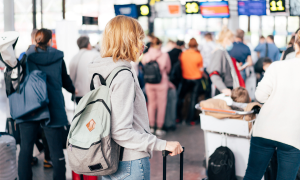

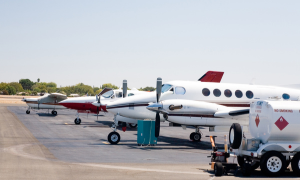
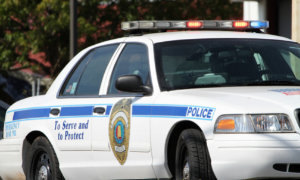

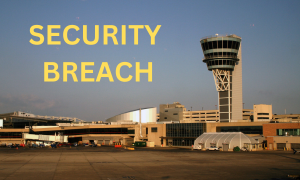
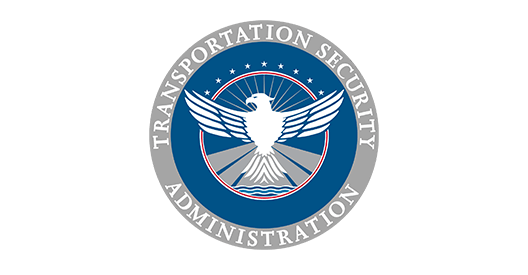



.png)

